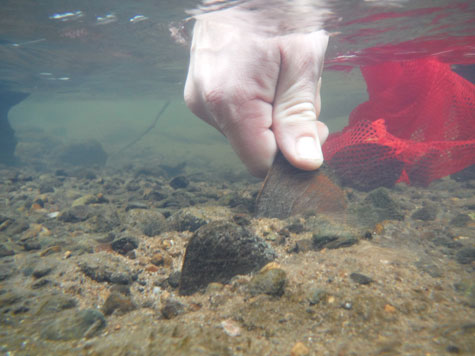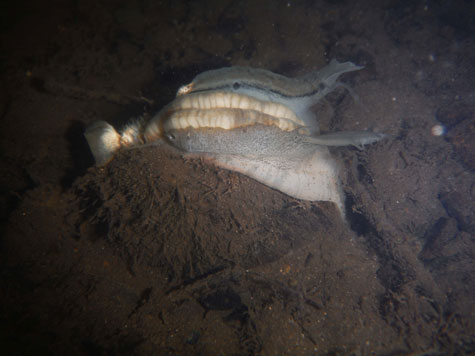What’s lurking at the bottom of the river
In the mid-1990s, I was looking through a glass bottom bucket to see the bottom of Davis Creek. I had lost my water temperature monitor. Instead of finding the monitor, I spotted an unusual scene—a fish caught between the two valves of a freshwater mussel. How odd is that! I went to grab my camera but didn’t get it in time.
A few weeks later I received a call from Professor Chris Barnhart at Missouri State University. “Did I ever see a mussel capture a fish when I was out in the field?” he inquired. “Funny that you asked,” I replied. Dr. Barnhart had observed in the lab what I had observed in the field.

Unionids have a parasitic larval stage
Mussels catch fish each spring and summer in the tributaries of the Huron River, where the snuffbox mussel (Epioblasma triquetra) lives. The federally endangered snuffbox is one of the 31 native mussel species in the family Unionidae that have been recorded in the Huron River. Often referred to as “unionids,” these mussels have bivalved (two-valved) larvae, called glochidia (rhymes with the name “Lydia”) that must attach to the gills or fins of a fish to metamorphose into its next stage as a juvenile mussel.
The female snuffbox needs to get its larvae to a particular species of fish, the logperch (Percina caprodes), and has a clever way of capturing the fish. As the logperch turns rocks over on the bottom of a stream or river to look for food, the snuffbox, resembling a rock, captures the fish between its valves and then pumps its larvae onto the fish’s gills. This relationship is highly specialized, as only the logperch’s skull can take the force of the snuffbox’s grasp.
While the snuffbox needs one host fish species, other unionids, such as the commonly found giant floater (Pyganodon grandis), may use many fish species; other types of mechanisms are used to get the glochidia to the fish. Some mussels release glochidia in little packets, called “conglutinates.” Some conglutinates resemble worms, aquatic insect larvae or even fish fry. Two mussels commonly found in the Huron River, the plain pocketbook (Lampsilis cardium) and the state endangered wavy-rayed lampmussel (Lampsilis fasciola), have modified mantle flaps that resemble minnows. The mussels twitch their mantle flaps, putting on a show that resembles a live fish. Both the plain pocketbook and wavy-rayed lampmussel use bass as their fish hosts, so the unknowing predatory fish goes to eat the “minnow” and becomes infested with the glochidia.
To see a snuffbox capture a logperch, you can visit Missouri State’s Unio Gallery. The gallery has photos of mussels similar to species found in Michigan, showing the different types of fish lures used by the unionids.
Mussels provide ecosystem services
Because the mussels need healthy fish to continue their life cycle, it is unlikely that the larvae kill the fish. In fact, the parasitic glochidia may help fish develop immunities to other parasites. Mussels also provide ecosystem services in the waters where the fish live. Mussel beds provide habitat for aquatic insects and other macroinvertebrates. As filter feeders, unionids recycle and store nutrients, and even modify food webs. Since mussels don’t move very far and are sensitive to pollutants, their presence usually indicates good water quality.
Other small bivalved mollusks you may observe in the Huron include the pea or fingernail clams (family Sphaeridae) or the non-native Asian clam (Corbicula spp.) The invasive zebra mussels (Dreissena polymorpha) and quagga mussels (Dreissena bugenensis) have threads to attach to rocks or other hard substrates. None of these other bivalves have the unusual parasitic life cycle of the unionids.
Unionids are one of the most imperiled faunas

Unfortunately, about 70% of the North American unionids are imperiled. Pollution, altering waterways, and most recently the zebra and quagga mussels have decimated these sensitive species. Zebra and quagga mussels like to settle on the unionids, which creates a burden for them energy-wise and prevents the native mussels from eating. Invasive mussels upstream of a dam can also deplete the food sources that the unionids need downstream.
Another historical reason for the decline in mussel populations was the button industry. Before there were plastic buttons, there were freshwater shell buttons, made from the thicker shelled unionids. In some areas of Michigan where button factories existed, you can still find old shells with round holes where slugs were cut to make buttons.
While shell collecting of unionids used to be a hobby, collection is now restricted. Any handling of the federally listed species (including the snuffbox) is only allowed with federal permits. Permits are needed from the Michigan Department of Natural Resources to collect common and state threatened and endangered species. This is mainly done to protect all mussels in Michigan. So, observing the mussels in the rivers is fine, but collecting them is not.
There is good news on the conservation front, however. Researchers at Central Michigan University and governmental agencies in the U.S. have started propagating freshwater mussels in hopes of reseeding some populations. Water quality in general has improved since the Clean Water Act, and populations once harvested for the button industry have rebounded. Michigan has implemented requirements to relocate mussels if they are being impacted by instream construction projects, including bridge replacements. The remedy is very easy—the mussels are just moved to another area so that they won’t be dredged, crushed, or harmed in other ways.
―Renee Mulcrone, PhD, Guest Author
Dr. Mulcrone has been working on freshwater mussel projects in Michigan for 30 years. She is a biologist for ASTI Environmental, an adjunct instructor at Eastern Michigan University, and she lives in the Horseshoe Creek watershed.
This blog post was originally published June 1st in the Huron River Report, Summer 2020.



